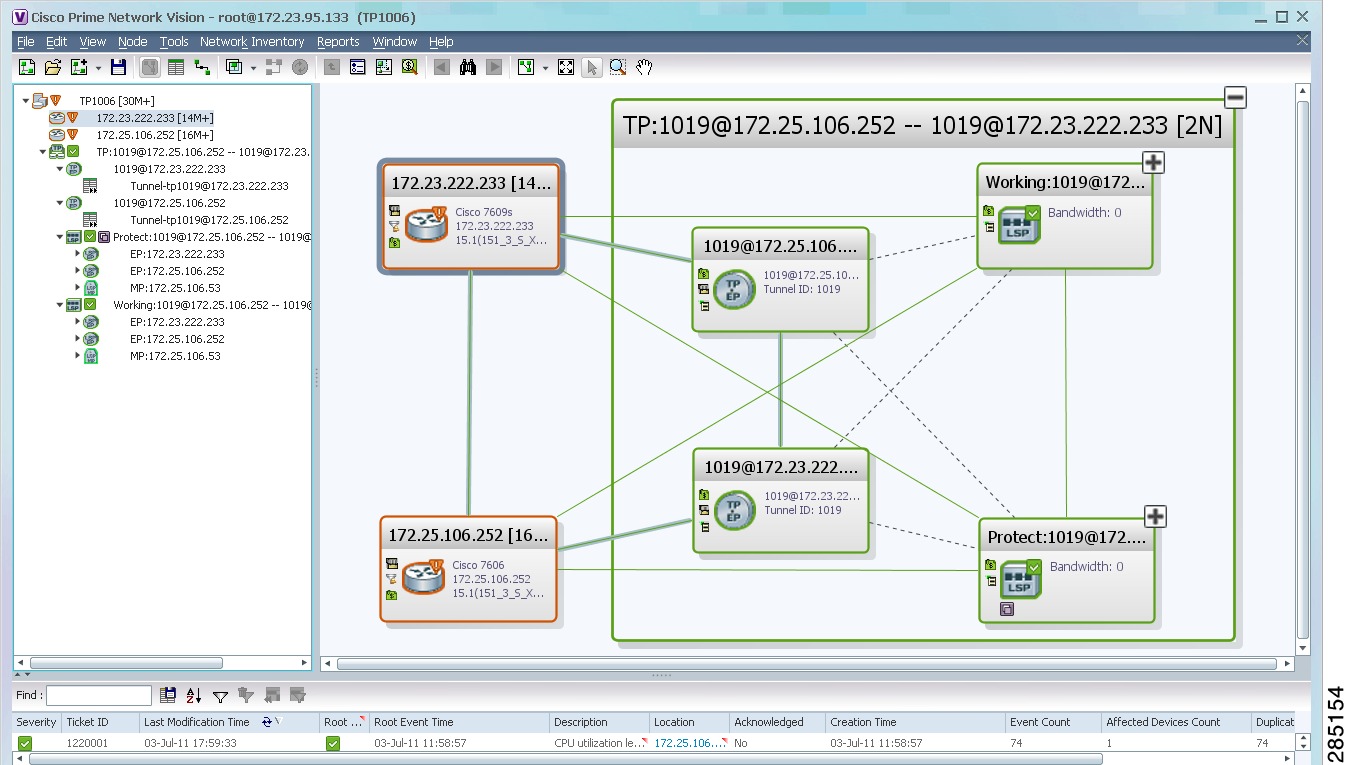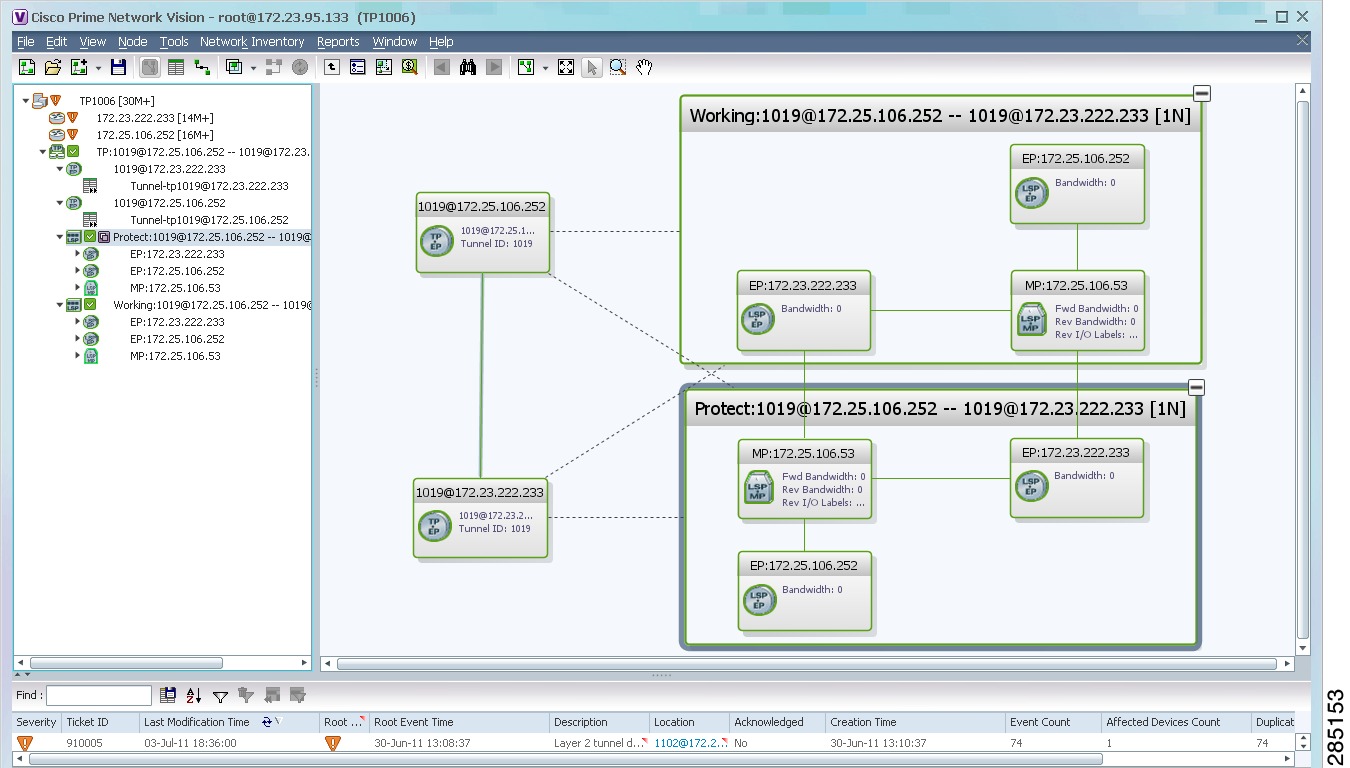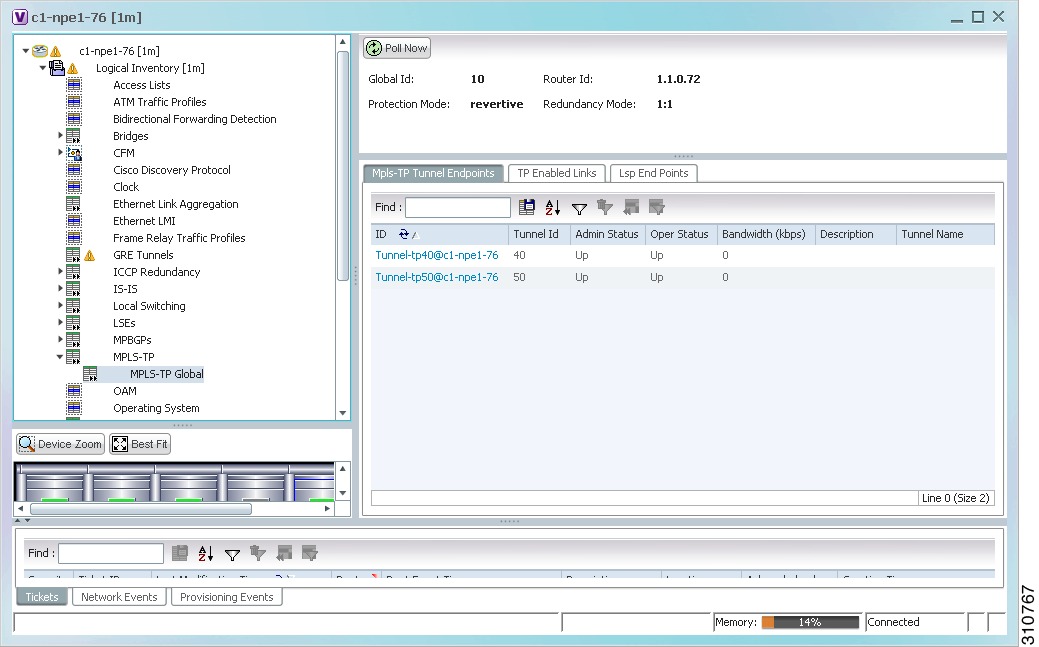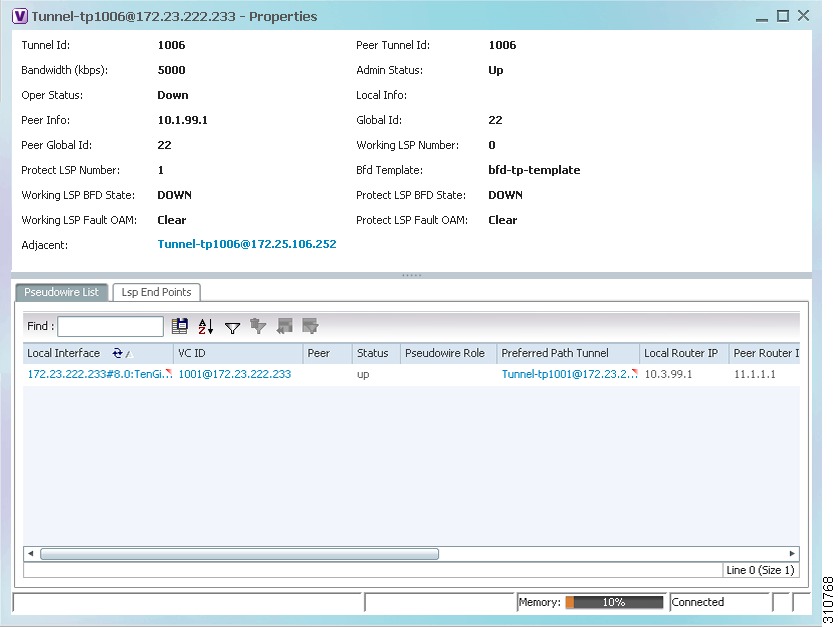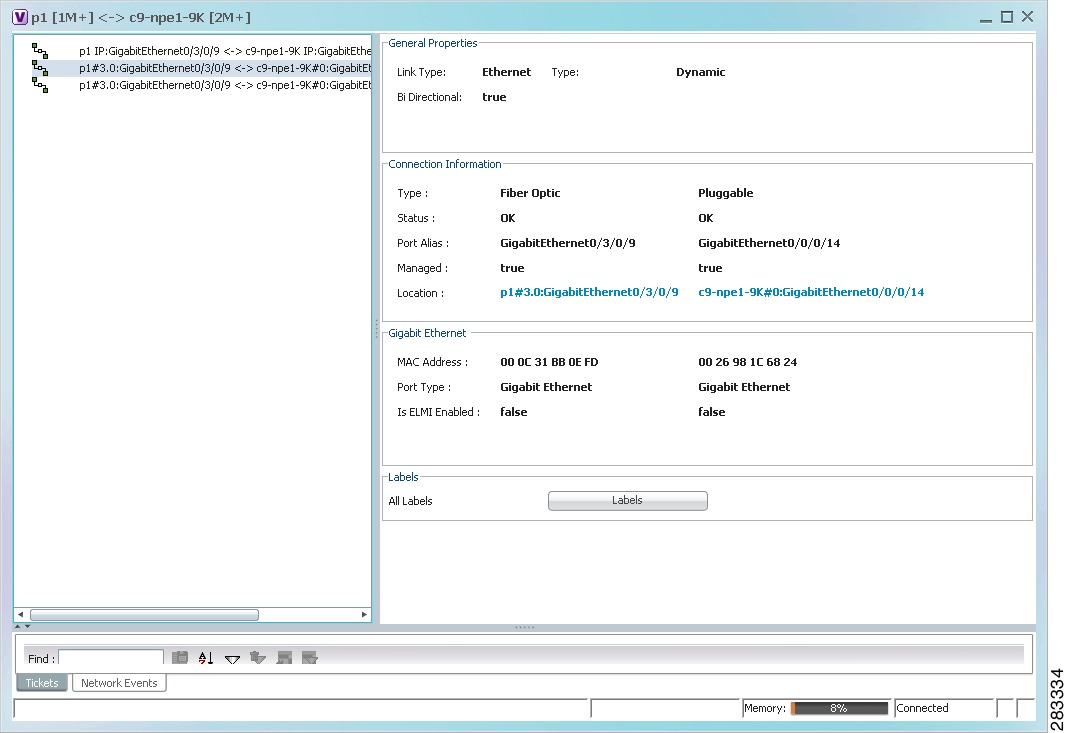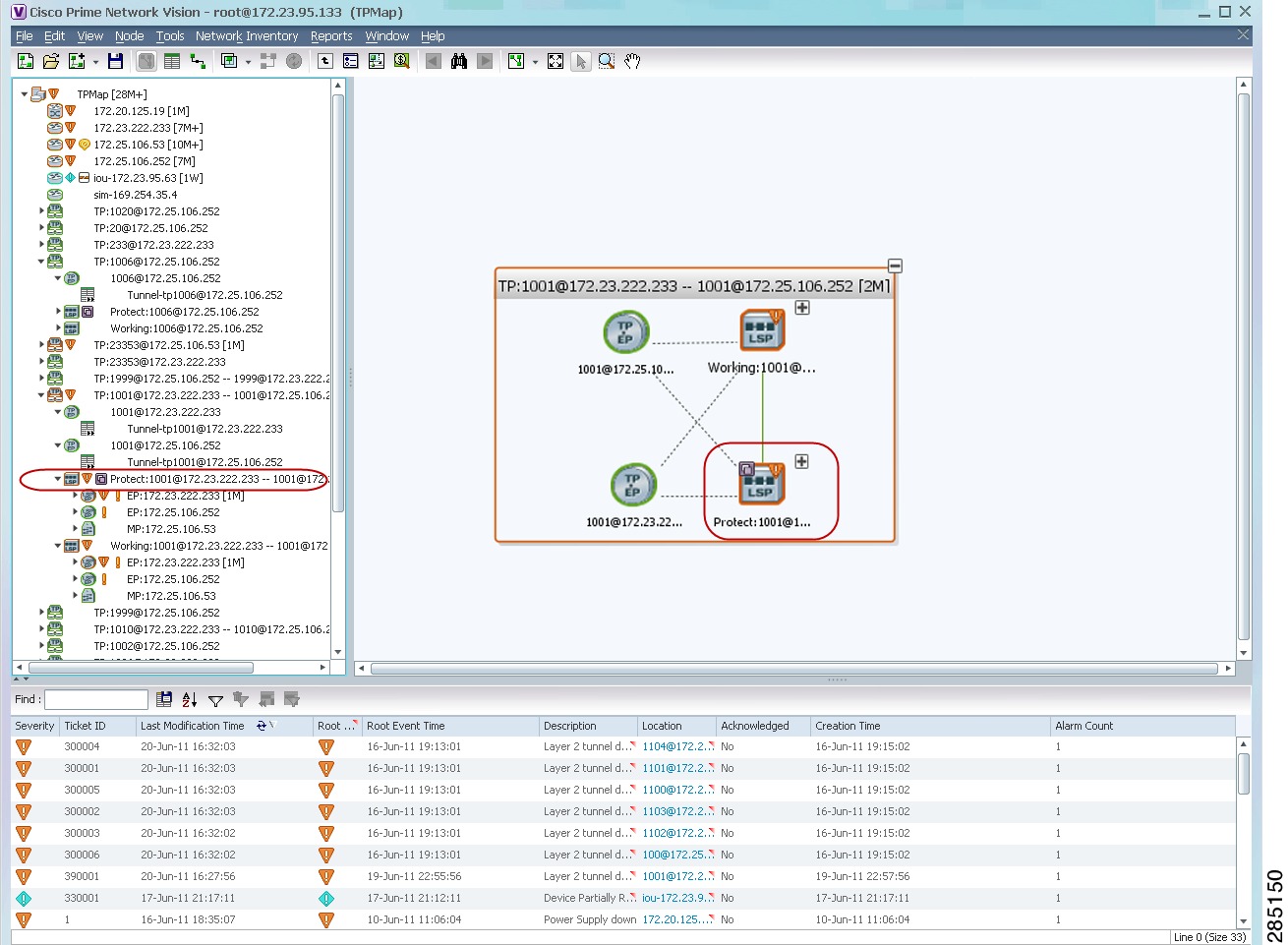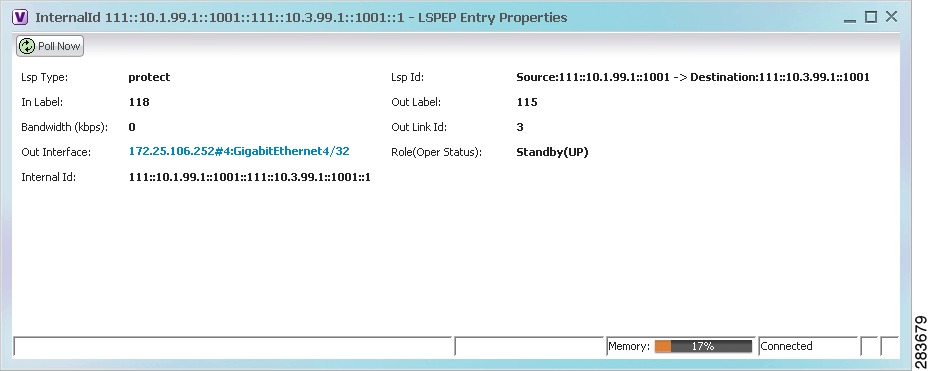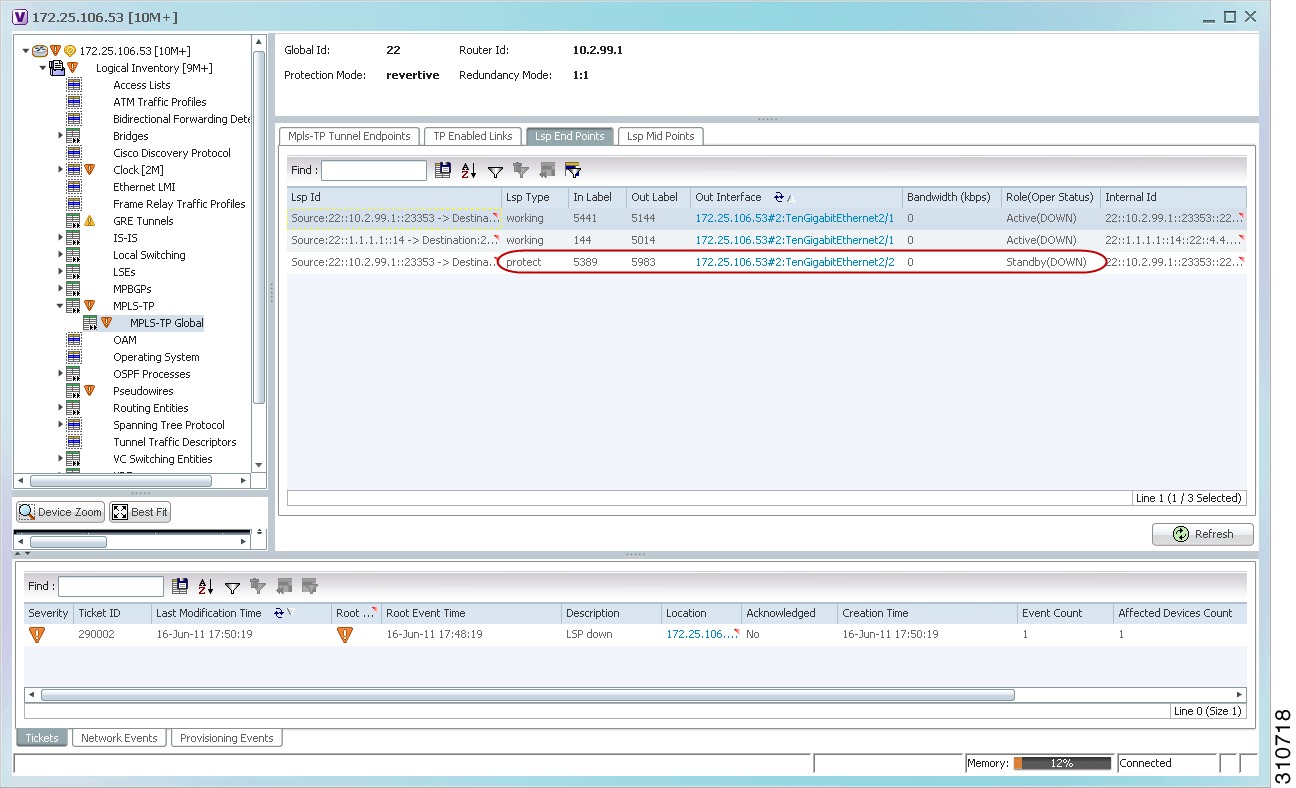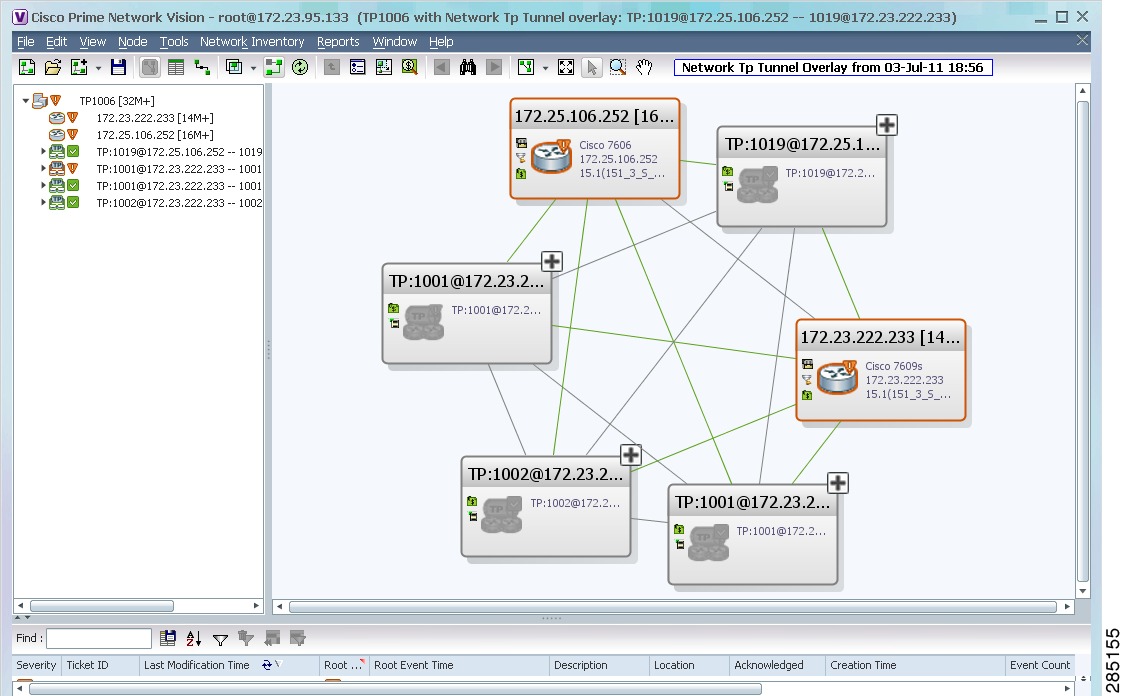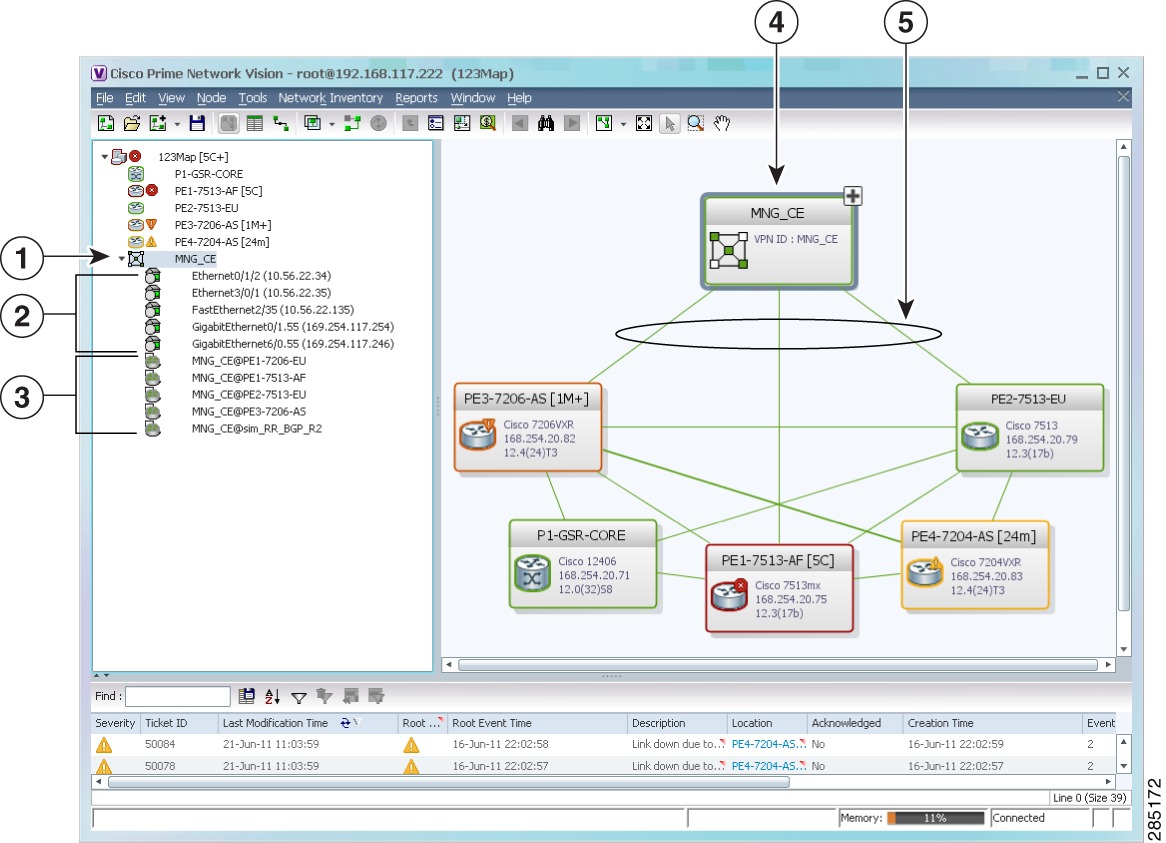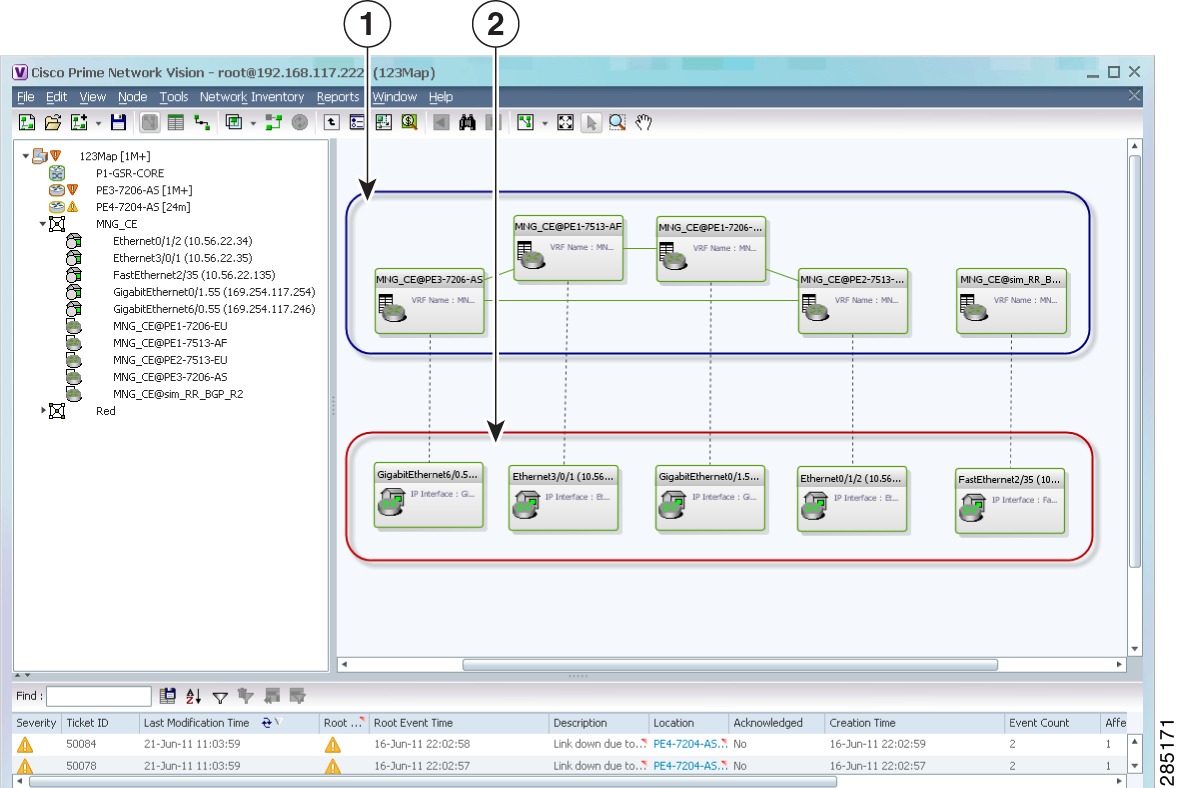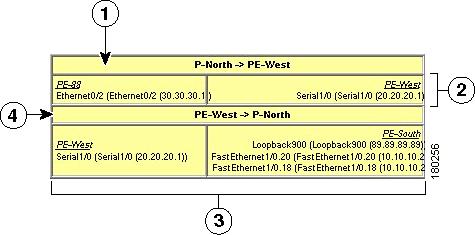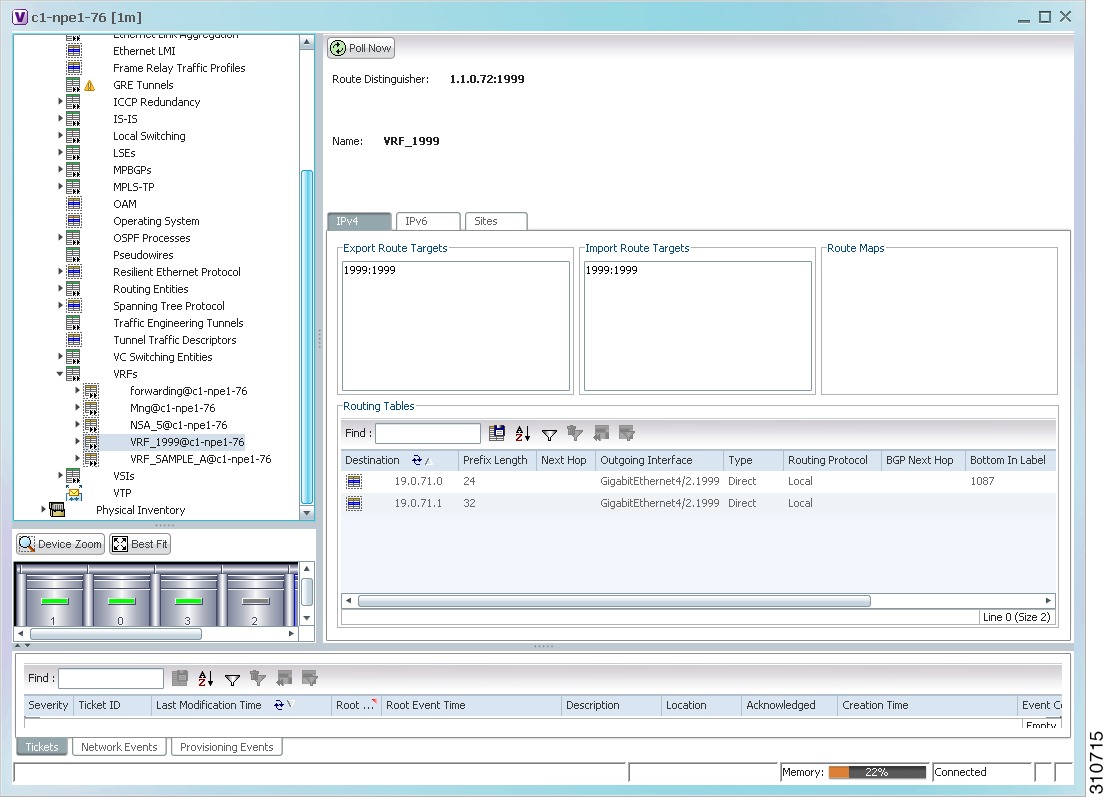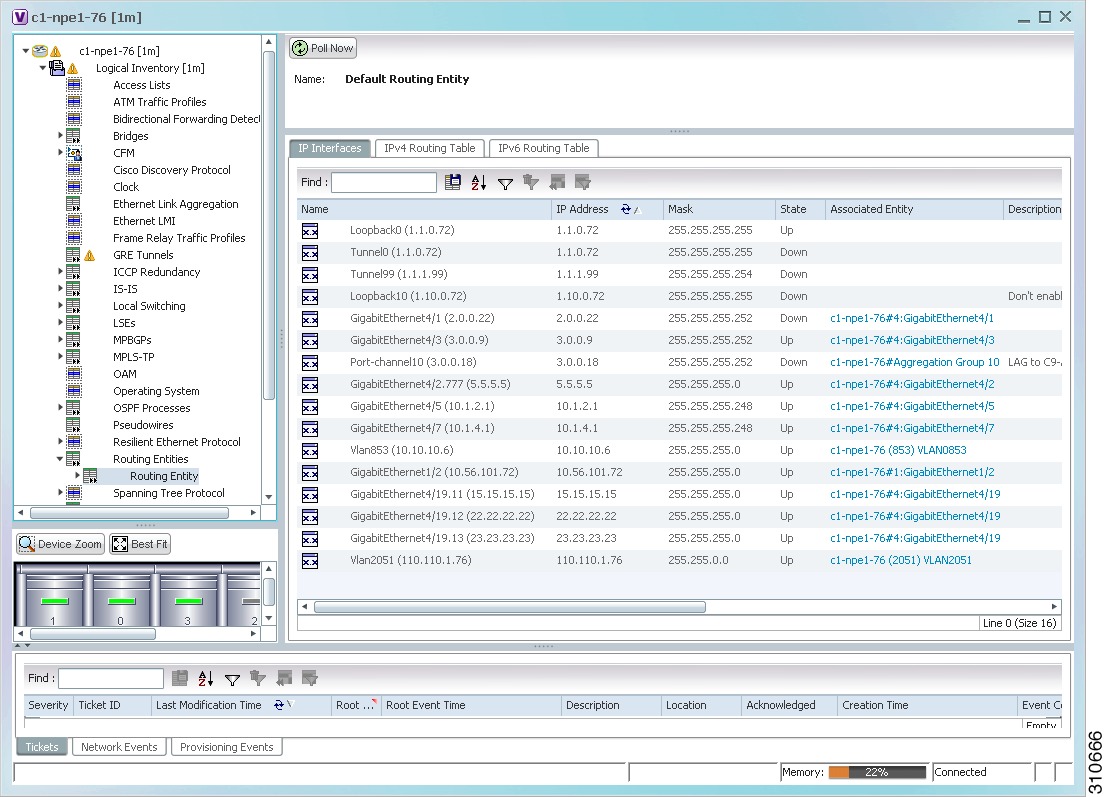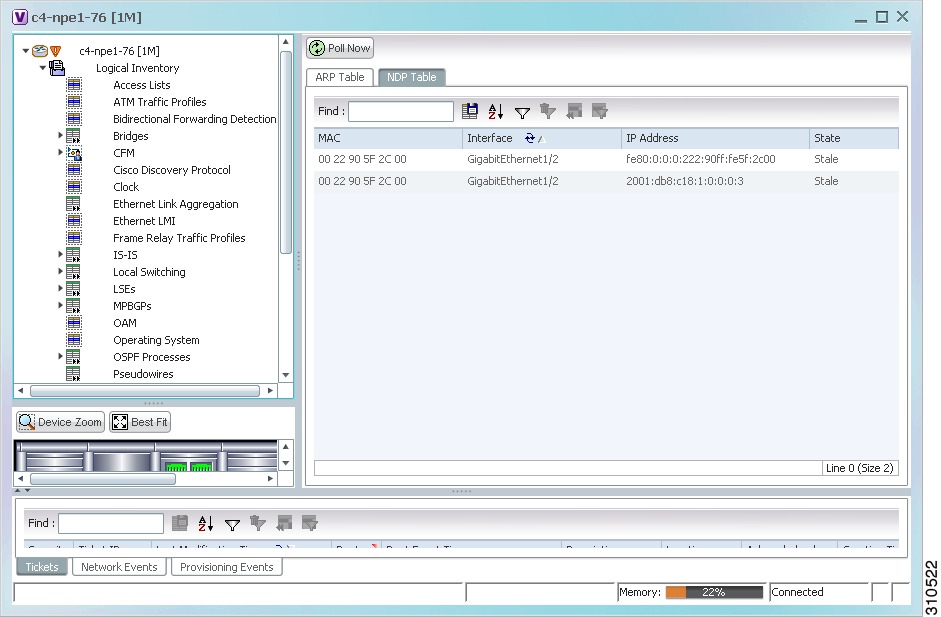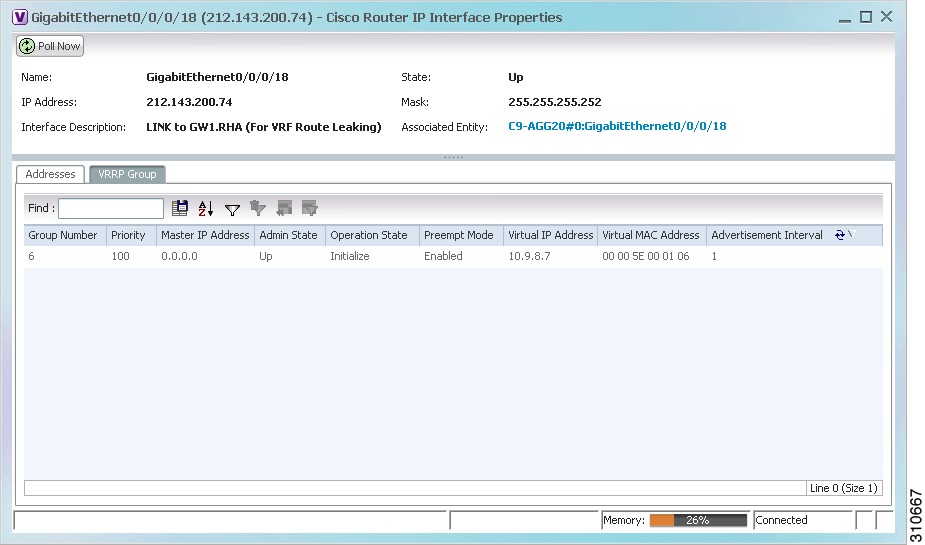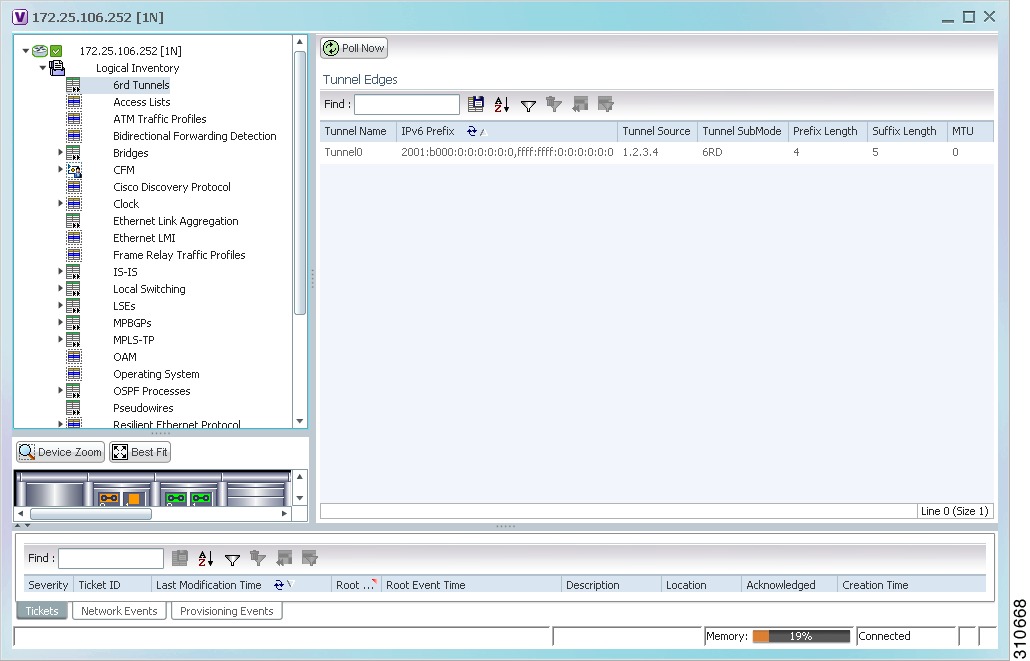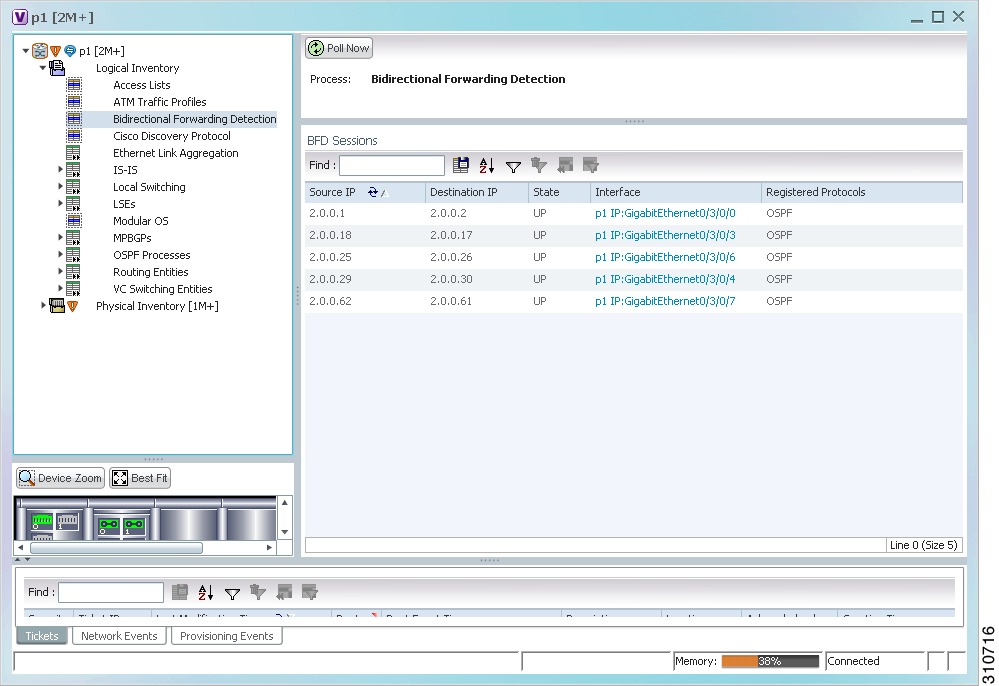

-
Cisco Prime Network User Guide, 3.9
-
Preface
-
Cisco Prime Network Client Overview
-
Working with the Cisco Prime Network Vision Client
-
Viewing Network Element Properties
-
Working with Prime Network Vision Maps
-
Working with Links
-
Working with Business Tags and Business Elements
-
Working with the Prime Network Events Client
-
Tracking Faults Using Prime Network Events
-
Working with Tickets in Cisco Prime Network Vision
-
Working with Reports
-
Using Cisco PathTracer to Diagnose Problems
-
Monitoring Carrier Ethernet Services
-
Monitoring Carrier Grade NAT Properties
-
Monitoring DWDM Properties
-
Viewing Ethernet Operations, Administration, and Maintenance Tool Properties
-
IPv6 and IPv6 VPN over MPLS
-
Monitoring MPLS Services
-
Monitoring MToP Services
-
Viewing SBC Properties
-
Viewing Mobile Technologies in Prime Network
-
Icon and Button Reference
-
Index
-
Table Of Contents
User Roles Required to Work with MPLS Networks
Viewing MPLS-TP Tunnel Properties
Viewing LSPs Configured on an Ethernet Link
Viewing LSP Endpoint Redundancy Service Properties
Applying an MPLS-TP Tunnel Overlay
Viewing Additional VPN Properties
Moving a Virtual Router Between VPNs
Managing a VPN Overlay Display in the Map View
Displaying VPN Callouts in a VPN Overlay
Viewing VRF Egress and Ingress Adjacents
Viewing Rate Limit Information
Viewing Label Switched Entity Properties
Viewing BFD Session Properties
Viewing Cross-VRF Routing Entries
Viewing Pseudowire End-to-End Emulation Tunnels
Viewing MPLS TE Tunnel Information
Monitoring MPLS Services
The following topics describe how to view and manage aspects of Multiprotocol Label Switching (MPLS) services using Cisco Prime Network Vision (Prime Network Vision), including the MPLS service view, business configuration, and maps. The topics also describe the device inventory specific to MPLS VPNs, including routing entities, label switched entities (LSEs), BGP neighbors, Multiprotocol BGP (MP-BGP), VRF instances, pseudowires, and TE tunnels. Topics include:
•
User Roles Required to Work with MPLS Networks
User Roles Required to Work with MPLS Networks
This topic identifies the roles that are required to work with MPLS networks. Prime Network determines whether you are authorized to perform a task as follows:
•
For GUI-based tasks (tasks that do not affect elements), authorization is based on the default permission that is assigned to your user account.
•
For element-based tasks (tasks that do affect elements), authorization is based on the default permission that is assigned to your account. That is, whether the element is in one of your assigned scopes and whether you meet the minimum security level for that scope.
For more information on user authorization, see the Cisco Prime Network 3.9 Administrator Guide.
The following tables identify the tasks that you can perform:
•
Table 17-1 identifies the tasks that you can perform if a selected element is not in one of your assigned scopes.
•
Table 17-2 identifies the tasks that you can perform if a selected element is in one of your assigned scopes.
By default, users with the Administrator role have access to all managed elements. To change the Administrator user scope, see the topic on device scopes in the Cisco Prime Network 3.9 Administrator Guide.
Working with MPLS-TP Tunnels
MPLS-Transport Profile (MPLS-TP) is considered to be the next generation transport for those using SONET/SDH TDM technologies as they migrate to packet-switching technology. Although still under definition by the IETF, MPLS-TP provides:
•
Predetermined and long-lived connections.
•
Emphasis on manageability and deterministic behavior.
•
Fast fault detection and recovery.
•
Inband OAM.
MPLS-TP features include:
•
Manually provisioned MPLS-TP LSPs.
•
Reserved bandwidth for static MPLS-TP LSPs.
•
One-to-one path protection for MPLS-TP LSPs.
•
Working/Protected LSP switchover.
•
Continuity Check (CC), Proactive Continuity Verification (CV), and Remote Defect Indication (RDI) based on BFD.
•
New fault OAM functions resulting from the MPLS-TP standardization effort.
Prime Network automatically discovers network MPLS-TP tunnels from end to end, including LSPs, tunnel endpoints, and bandwidth. Network LSPs contain LSP endpoints and midpoints and are identified as working or protected.
Prime Network links the MPLS-TP tunnel components appropriately, provides a visual representation in Prime Network Vision maps, and displays the properties in logical inventory.
Prime Network employs warm start technology when rebooting. That is, when rebooting, Prime Network compares existing MPLS-TP tunnel information to topology changes that occur while Prime Network is down and updates MPLS-TP tunnel accordingly when Prime Network returns to operation.
The following options are available for working with MPLS-TP tunnels in Prime Network Vision:
•
Viewing MPLS-TP Tunnel Properties
•
Viewing LSPs Configured on an Ethernet Link
•
Viewing LSP Endpoint Redundancy Service Properties
•
Applying an MPLS-TP Tunnel Overlay
•
Viewing MPLS-TP BFD session properties—See Viewing BFD Session Properties.
Adding an MPLS-TP Tunnel
Prime Network Vision automatically discovers MPLS-TP tunnels, endpoints, and midpoints and enables you to add MPLP-TP tunnels to maps.
To add an MPLS-TP tunnel to a map:
Step 1
In Prime Network Vision, display the map to which you want to add the MPLS-TP tunnel.
Step 2
Do either of the following:
•
From the File menu, choose Add to Map > MPLS-TP Tunnel.
•
In the main toolbar, click Add to Map, then choose Add to Map > MPLS-TP Tunnel.
The Add MPLS-TP Tunnel dialog box is displayed.
Step 3
Do either of the following:
•
Choose a search category, enter a search string, then click Go to narrow search results to a range of MPLS-TP tunnels or a specific MPLS-TP tunnel. Search categories include:
–
Description
–
Name
–
System Name
•
Choose Show All to display all the MPLS-TP tunnels.
Step 4
Select the MPLS-TP tunnel that you want to add to the map.
Step 5
Click OK.
The MPLS-TP tunnel is added to the map and to the navigation pane.
In Figure 17-1:
•
The devices are on the left side of the map, and the MPLS-TP tunnel is displayed in a thumbnail on the right.
•
The devices are connected to each other and to the MPLS-TP tunnel via tunnels.
•
Physical links connect the devices to the Working and Protected LSPs.
•
A redundancy service badge is displayed next to the Protected LSP in the navigation and map panes.
•
In the thumbnail:
–
The tunnel endpoints are connected to each other via a tunnel.
–
A physical link connects the Working and Protected LSPs.
–
Business links connect the Working and Protected LSPs to each endpoint.
Figure 17-1 MPLS-TP Tunnel in Prime Network Vision Map
If an LSP is in lockout state, it is displayed with the lock badge (
).
By expanding all aggregations in the MPLS-TP tunnel (see Figure 17-2), you can see components and links in the MPLS-TP tunnel, including:
•
MPLS-TP tunnel endpoints
•
LSP endpoints
•
LSP midpoints
Figure 17-2 MPLS-TP Tunnel Expanded
If an LSP is configured for redundancy service, a redundancy service badge is applied to the secondary (backup) LSP in the navigation and map panes in the navigation and map panes.
For more information about LSP redundancy service, see Viewing LSP Endpoint Redundancy Service Properties.
Viewing MPLS-TP Tunnel Properties
Prime Network Vision discovers and displays MPLS-TP attributes in the MPLS-TP branch in logical inventory as described in this topic.
Additional information about MPLS-TP tunnel properties are available in the following branches:
•
Routing Entities—See Viewing Routing Entities.
•
LSEs—See Viewing Label Switched Entity Properties.
•
Pseudowires— See Viewing Pseudowire End-to-End Emulation Tunnels.
To view MPLS-TP tunnel properties:
Step 1
Right-click the required device in Prime Network Vision and choose Inventory.
Step 2
In the logical inventory window, choose Logical Inventory > MPLS-TP > MPLS-TP Global.
The routing information is displayed as shown in Figure 17-3.
Figure 17-3 MPLS-TP Tunnel Properties in Logical Inventory
Table 17-3 describes the information that is available for MPLS-TP tunnels. The information that is displayed depends on the configuration.
Step 3
To view additional MPLS-TP tunnel endpoint properties, double-click the required entry in the MPLS-TP Tunnel Endpoints table.
The MPLS-TP Tunnel Properties window is displayed as shown in Figure 17-4.
Figure 17-4 MPLS-TP Tunnel Properties Window
Table 17-4 describes the information available in the top portion of the MPLS-TP Tunnel Properties window. For information about the tabs that are displayed, see Table 17-3.
Viewing LSPs Configured on an Ethernet Link
A single Ethernet link can support a number of LSPs. Prime Network Vision enables you to view all LSPs on a single Ethernet link and to identify the source and destination labels.
To view LSPs configured on an Ethernet link:
Step 1
In the map view, right-click the required link and choose Properties.
Step 2
In the link properties window, choose the required Ethernet link.
The link properties window refreshes and displays the Labels button as shown in Figure 17-5.
Figure 17-5 Link Properties Window with All Labels Button
Step 3
Click Labels.
The All Labels window is displayed as shown in Figure 17-6 with the LSP sources and destinations.
Figure 17-6 All Labels Table
Step 4
To identify a specific path, click an outgoing label in the Source table. The corresponding in label is selected in the Destination table.
Viewing LSP Endpoint Redundancy Service Properties
If an LSP endpoint in an MPLS-TP tunnel is configured for redundancy service, a redundancy service badge is applied to the secondary (backup) LSP endpoint in the navigation and map panes in Prime Network Vision. Additional redundancy service details are provided in the LSP endpoint properties window and the inventory window for the element on which the MPLS-TP tunnel is configured.
To view LSP endpoint redundancy service properties:
Step 1
To determine if an LSP endpoint on an MPLS-TP tunnel is configured for redundancy service, expand the required MPLS-TP tunnel in the navigation or map pane.
If the LSP endpoint is configured for redundancy service, the redundancy service badge is displayed in the navigation and map panes as shown in Figure 17-7.
Figure 17-7 LSP Endpoint with Redundancy Service Badge
Step 2
To view properties for the LSP endpoint, navigate to and right-click the required endpoint in the map or navigation pane, and choose Properties.
The LSP endpoint properties window is displayed as shown in Figure 17-8.
Figure 17-8 LSP Endpoint Properties Window
Table 17-5 describes the information displayed in the LSP Endpoint Properties window.
Step 3
To view LSP endpoint redundancy status in inventory, double-click the element on which the MPLS-TP tunnel is configured.
Step 4
Choose Logical Inventory > MPLS-TP > MPLS-TP Global > LSP End Points.
Step 5
The LSP End Points tab contains the following information related to LSP redundancy service (see Figure 17-9):
•
Whether the LSP endpoint is Working or Protected.
•
The LSP endpoint role, either Active or Standby.
•
The operational status of the LSP endpoint, either Up or Down.
Figure 17-9 LSP End Points Tab in Logical Inventory
Applying an MPLS-TP Tunnel Overlay
You can select and display an overlay of a specific MPLS-TP tunnel on top of the devices displayed in a map view. The overlay is a snapshot of the network that visualizes the flows between the sites and tunnel peers. When an MPLS-TP tunnel is selected in the map, the following elements are highlighted in the map:
•
Elements on which TP endpoints and LSPs are configured.
•
Links that carry TP traffic.
All elements and links that are not part of the MPLS-TP tunnel are dimmed.
To apply an MPLS-TP tunnel overlay:
Step 1
In Prime Network Vision, display the network map on which you want to apply an overlay.
Step 2
From the main toolbar, click Choose Overlay Type and choose MPLS-TP tunnel.
The Select MPLS-TP tunnel Overlay dialog box is displayed.
Step 3
Do one of the following:
•
Choose a search category, enter a search string, then click Go to narrow the search results to a range of MPLS-TP tunnels or a specific MPLS-TP tunnel. Search categories include:
–
Description
–
Name
–
System Name
The search condition is "contains." Search strings are case-insensitive. For example, if you choose the Name category and enter "net," Prime Network Vision displays MPLS-TP tunnels that have "net" in their names whether net appears at the beginning of the name, the middle, or at the end: for example, Ethernet.
•
Choose Show All to display all MPLS-TP tunnels.
Step 4
Select the MPLS-TP tunnel overlay you want to apply to the map.
The elements and links used by the selected MPLS-TP tunnel are highlighted in the network map, and the MPLS-TP tunnel name is displayed in the window title bar as shown in Figure 17-10.
Figure 17-10 MPLS-TP Tunnel Overlay
Note
An overlay is a snapshot taken at a specific point in time and does not reflect changes that occur in the service. As a result, the information in an overlay can become stale. To update the overlay, click Refresh Overlay in the main toolbar.
Viewing VPNs
Figure 17-11 shows a VPN displayed in the Prime Network Vision map view. In this example, the VPN is selected in the navigation pane, so the VPN details, such as virtual routers and IP interfaces, are not shown in the map view.
Figure 17-11 VPN in Prime Network Vision Map View
VPN in the navigation tree
VPN in the map view
Sites
VPN links (IPv4 and IPv6 aware)
Virtual routers
Figure 17-12 shows a VPN with details, including virtual routers and sites, in the Prime Network Vision map view.
Figure 17-12 VPN in Prime Network Vision Map View with VRFs and Sites
The Prime Network Vision navigation pane displays the VPN business elements in a tree-and-branch representation. Each business element is represented by an icon in a color that reflects the highest alarm severity. The icon might also have a management state badge or alarm. For more information about icon severity colors and badges, see Prime Network Vision Status Indicators.
Table 17-6 shows the VPN icons in the Prime Network Vision map view.
Table 17-6 VPN Icons in Prime Network Vision Map View
Root (map name) or aggregation
VPN
Virtual router
Site
The highest level of the navigation pane displays the root or map name. The branches display the VPN and aggregated business elements as well as their names. The Layer 3 VPN sub-branch displays the virtual routers and sites contained in the VPN along with the names of the business elements. In addition, CE devices can be displayed in the Layer 2 and Layer 3 VPN sub-branches. If you select an aggregated business element in the navigation pane, the map view displays the business elements contained within the aggregated business element.
The Prime Network Vision map view displays the VPN business elements and aggregated business elements loaded in the map view, along with the names of the business elements. In addition, the map view displays the VPN topology (between the virtual routers in the VPNs) and the topology and associations between other business elements. After you select the root in the navigation pane, the map view displays all the VPNs.
Prime Network Vision presents tickets related to the map in the ticket area, which allows you to view and manage the VPN tickets.
Viewing Additional VPN Properties
Prime Network Vision allows you to select any element in the navigation pane or map view and view additional underlying properties. To view additional properties for an object, either double-click it or right-click it and choose Properties. Table 17-7 shows the additional properties available for VPN entities.
Managing VPNs
The following topics describe:
•
Moving a Virtual Router Between VPNs
Creating a VPN
You can change business configurations by manually creating VPNs. The VPNs that are manually created do not contain virtual routers and sites.
To create a VPN:
Step 1
In the Prime Network Vision navigation pane, select the map root.
Step 2
From the File menu, choose Add to Map > VPN > New.
Step 3
In the Create VPN dialog box, enter the following:
•
Name—A unique name for the new VPN.
Note
VPN business element names are case sensitive.
•
Icon—To use a custom icon for the VPN, click the button next to the Icon field and navigate to the icon file.
Note
If a path is not specified to an icon, the default VPN icon is used (for more information about icons, see Table 17-6).
•
Description—(Optional) An additional VPN description.
Step 4
Click OK.
The new VPN is added to the VPN list in the Add VPN dialog box.
For more information about loading the newly created VPN in the service view map, see Adding a VPN to a Map.
Adding a VPN to a Map
You can add a VPN to a map view if the VPN was previously created by a user or discovered by Prime Network Vision and are not currently displayed in the map.
Note
Adding a VPN affects other users if they are working with the same map.
To add an existing VPN to a map:
Step 1
In Prime Network Vision, display the map to which you want to add the VPN.
Step 2
Do either of the following:
•
From the File menu, choose Add to Map > VPN > Existing.
•
In the main toolbar, click Add to Map, then choose Add to Map > VPN > Existing.
The Add VPN dialog box is displayed.
Step 3
Do either of the following:
•
Choose a search category, enter a search string, then click Go to narrow search results to a range of VPNs or a specific VPN. Search categories include:
–
Description
–
Name
The search condition is "contains." Search strings are case-insensitive. For example, if you choose the Name category and enter "net," Prime Network Vision displays VPNs that have "net" in their names whether at the beginning of the name, the middle, or the end.
•
Choose Show All to display all the VPNs.
Step 4
Select the VPN that you want to add to the map.
Tip
Press Shift or Ctrl to choose multiple adjoining or nonadjoining VPNs.
Step 5
Click OK.
The VPN is displayed in the navigation pane and the selected map or subnetwork in the Prime Network Vision window content pane. In addition, any tickets are displayed in the ticket area.
Removing a VPN from a Map
You can remove one or more VPNs from the current active map. This change does not affect other maps. Removing a VPN from a map does not remove it from the Prime Network Vision database. The VPN will appear in the Add VPN dialog box, so you can add it back to the map at any time.
When removing VPNs from maps, keep the following in mind:
•
Removing a VPN affects other users if they are working with the same map view.
•
This option does not change the business configuration or database.
•
You cannot remove virtual routers or sites from the map without removing the VPN.
To remove a VPN, in the Prime Network Vision pane or map view, right-click the VPN and choose Remove from Map.
The VPN is removed from the map view along with all VPN elements, such as connected CE devices. Remote VPNs (extranets) are not removed.
Note
If the routing information changes after an overlay is applied, the changes do not appear in the current overlay. Click Refresh Overlay to update the routing information.
Moving a Virtual Router Between VPNs
You can move a virtual router (including its sites) from one VPN to another after you create a VPN and add it to the service view map.
Note
Moving a virtual router moves all of its sites as well.
To move a virtual router:
Step 1
In the Prime Network Vision navigation pane or map, right-click the virtual router and choose Edit > Move selected.
Step 2
Right-click the required VPN in the navigation pane or map to where you want to move the virtual router and choose Edit > Move here.
CautionMoving a virtual router from one VPN to another affects all users who have the virtual router loaded in their service view map.
The virtual router and its sites are displayed under the selected VPN in the navigation pane and in the map.
Working with VPN Overlays
The following topics describe:
•
Managing a VPN Overlay Display in the Map View
•
Displaying VPN Callouts in a VPN Overlay
Applying VPN Overlays
You can select and display an overlay of a specific VPN on top of the devices displayed in a map view. The overlay is a snapshot of the network that visualizes the flows between the sites and tunnel peers. When one network VPN is selected in the network map, the PE routers, MPLS routers, and physical links that carry the LSP used by the VPN are highlighted in the network map. All the devices and links that are not part of the VPN are dimmed.
The VPN service overlay allows you to isolate the parts of a network that are being used by a particular service. This information can then be used for troubleshooting. For example, the overlay can highlight configuration or design problems when bottlenecks occur and all the site interlinks use the same link.
To apply a VPN overlay:
Step 1
In Prime Network Vision, display the network map on which you want to apply an overlay.
Step 2
From the main toolbar, click Choose Overlay Type and choose VPN.
The Select VPN Overlay dialog box is displayed.
Step 3
Do one of the following:
•
Choose a search category, enter a search string, then click Go to narrow the search results to a range of VPNs or a specific VPN. Search categories include:
–
Description
–
Name
The search condition is "contains." Search strings are case-insensitive. For example, if you choose the Name category and enter "net," Prime Network Vision displays VPNs that have "net" in their names whether net appears at the beginning of the name, the middle, or at the end: for example, Ethernet.
•
Choose Show All to display all the VPNs.
Step 4
Select the VPN overlay that you want to apply to the map.
The PE routers, MPLS routers, and physical links used by the selected VPN are highlighted in the network map. The VPN name is displayed in the title of the window.
Note
An overlay is a snapshot taken at a specific point in time and does not reflect changes that occur in the service. As a result, the information in an overlay can become stale. To update the overlay, click Refresh Overlay in the main toolbar.
Managing a VPN Overlay Display in the Map View
After a VPN overlay is applied to a map, you can manage its display by using the overlay tools in the main toolbar:
•
To display the overlay, click Show Overlay on the main toolbar.
•
To hide an active overlay, click Hide Overlay on the main toolbar.
Note
The Show Overlay button is a toggle. When clicked, the overlay is displayed. When clicked again, the overlay is hidden.
•
To remove the VPN overlay, choose Show Overlay Type > None.
Displaying VPN Callouts in a VPN Overlay
You can display or hide the callouts for VPN links displayed in a VPN overlay to show the details of the sites that are interlinked through the selected links. The callouts (see Figure 17-13) enable you to view the VPN traffic links for a specific link (either bidirectional or unidirectional).
Note
The link must be displayed in the VPN overlay and not dimmed for you to display the link callouts.
Figure 17-13 Callouts Window
To display or hide the callouts:
Step 1
In the Prime Network Vision window, display the map view with the VPN overlay.
Step 2
Right-click the required link in the map view and choose Show Callouts.
Step 3
To hide the callouts, right-click the link in the map view that is displaying the callouts and choose Hide Callouts.
Monitoring MPLS Services
The following topics provide details for viewing MPLS services and technologies:
•
Viewing VRF Egress and Ingress Adjacents
•
Viewing Label Switched Entity Properties
•
Viewing BFD Session Properties
•
Viewing Cross-VRF Routing Entries
•
Viewing Pseudowire End-to-End Emulation Tunnels
•
Viewing MPLS TE Tunnel Information
Viewing VPN Properties
To view the properties of a VPN:
Step 1
In the Prime Network Vision navigation pane or map view, do either of the following:
•
If the VPN icon is of the largest size, click the Properties button.
•
Right-click the VPN and choose Properties.
The VPN Properties window displays the following information:
•
Name—Name of the VPN.
•
ID—Unique identifier assigned to the VPN.
Step 2
Click Close to close the VPN Properties dialog box.
Viewing Site Properties
Prime Network Vision enables you to view site properties, including the interfaces that are configured on the PE device. The displayed properties reflect the configuration that Prime Network Vision automatically discovered for the device.
To view site properties, in the Prime Network Vision navigation pane or map view, right-click the required site and choose Properties.
Table 17-8 describes the information that is displayed in the Router IP Interface Properties window:
Table 17-8 Router IP Interface Properties Window for Sites
Name
Name of the site, such as FastEthernet4/1.252.
State
Interface state, either Up or Down.
IP Address
IP address of the interface.
Mask
Network mask.
Interface Description
Description applied to the interface.
Associated Entity
Element and interface associated with the site, hyperlinked to its entry in physical inventory.
Subnet
IP address and subnet mask.
Note
If the site is an IPv6 VPN over MPLS with IPv6 addresses provisioned, the IPv6 addresses are displayed. For more information, see Viewing IPv6 Information.
Type
Address type, such as Primary, Secondary, or IPv6 Unicast.
Viewing VRF Properties
Prime Network Vision enables you to view VRF properties, including the VRF route distinguisher, import and export route targets, and any provisioned sites and VRF routes.
To view VRF properties, do either of the following in map view:
•
Double-click the element configured for VRFs.
•
Expand the required VPN and double-click the virtual router.
The VRF properties window is displayed as shown in Figure 17-14.
Figure 17-14 VRF Properties
The VRF Properties window contains the VRF routing table for the device. The table is a collection of routes that are available or reachable to all the destinations or networks in the VRF. The forwarding table also contains MPLS encapsulation information.
Table 17-9 describes the information displayed in the VRF Properties window.
Note
The VRF Properties window only displays properties and attributes that are provisioned in the VRF. You might not see all the fields and tabs described in Table 17-9.
Table 17-9 VRF Properties
Route Distinguisher
Name
VRF name.
Description
Description of the VRF.
Export Route Targets
IPv4 export route targets contained by the VRF.
Import Route Targets
IPv4 import route targets contained by the VRF.
Route Maps
Route maps for the VRF.
Export Route Targets
IPv6 export route targets contained by the VRF.
Import Route Targets
IPv6 import route targets contained by the VRF.
Route Maps
Route maps for the VRF.
Destination
Destination of the specific network.
Prefix Length
Length of the network prefix in bits.
Next Hop
Next routing hop.
Outgoing Interface
Name of the outgoing interface; displayed if the Routing Protocol type is local.
Type
Route type: Direct (local), Indirect, or Static.
Routing Protocol
Routing protocol used to communicate with the other sites and VRFs: BGP or local.
BGP Next Hop
Border Gateway Protocol (BGP) next hop. This is the PE address from which to continue to get to a specific address. This field is empty when the routing entry goes to the CE.
Bottom In Label
Innermost label that is expected when MPLS traffic is received.
Bottom Out Label
Innermost label sent with MPLS traffic.
Outer Label
Outermost or top label in the stack used for MPLS traffic.
Name
Site name.
IP Address
IP address of the interface.
Mask
Subnet mask.
State
State of the subinterface: Up or Down.
Associated Entity
Element and interface associated with the site, hyperlinked to its entry in physical inventory.
Description
Interface description.
Input Access List
Access list applied to the inbound traffic.
Output Access List
Access list applied to the outbound traffic.
Rate Limits
If a rate limit is configured on an IP interface, the limit is shown as an IP interface property. This option is checked when a rate limit is defined on the IP interface, meaning the access list is a rate limit access list. IP interface traffic is measured and includes the average rate, normal burst size, excess burst size, conform action, and exceed action.
Note
Double-clicking a row displays the properties of the IP interface. When a rate limit is configured on the IP interface, the Rate Limits tab is displayed. For more information about rate limits, see Viewing Rate Limit Information.
Note
The Input Access, Output Access, and Rate Limits parameters apply only to Cisco IOS devices.
IP Sec Map Name
IP Security (IPsec) map name.
Site Name
Name of the business element to which the interface is attached.
Viewing VRF Egress and Ingress Adjacents
Prime Network Vision enables you to view the exporting and importing neighbors by displaying the VRF egress and ingress adjacents. In addition, you can view the connectivity between the VRFs for the route targets and view their properties. For example, if VRF A retrieved route target import X, you can view all VRFs that export X as a route target whether it is in the same or another VPN.
To display the VRF egress and ingress adjacents, you can use either an element configured for VRFs or a virtual router:
•
To use an element configured for VRFs:
a.
Double-click the element configured for VRFs.
b.
In the inventory window, choose Logical Inventory > VRFs > vrf where vrf is the required VRF.
c.
Right-click the required VRF and choose Show VRF Egress Adjacents or Show VRF Ingress Adjacents.
•
To use a virtual router, right-click the required VRF in the navigation pane, and choose Show VRF Egress Adjacents or Show VRF Ingress Adjacents.
Table 17-10 describes the information displayed in the Adjacents window.
Viewing Routing Entities
To view routing entities:
Step 1
Right-click the required device in Prime Network Vision and choose Inventory.
Step 2
In the logical inventory window, choose Logical Inventory > Routing Entities > Routing Entity.
The routing information is displayed as shown in Figure 17-15.
Figure 17-15 Routing Entity Table
Table 17-11 describes the information that is displayed in the Routing Entity table.
Table 17-11 Routing Entity Table
Name
Name of the routing entity.
Name
Site name.
IP Address
IP address of the interface.
Mask
Network mask.
State
State of the subinterface: Up or Down.
Associated Entity
Interface associated with the routing entity, hyperlinked to its location in physical inventory.
Description
Description of the interface.
Input Access List
If an input access list is assigned to an IP interface, the list is shown as an IP interface property, and a hyperlink highlights the related access list in the Access List table. When an access list is assigned to the inbound traffic on an IP interface, the actions assigned to the packet are performed.
VRRP Group
If a VRRP group is configured on an IP interface, the information is shown as an IP interface property. This option is checked when a rate limit is defined on the IP interface.
Note
Double-clicking a row displays the properties of the IP interface. When a VRRP group is configured on an IP interface, the VRRP Groups tab is displayed in the IP Interface Properties window. For more information, see Viewing VRRP Information.
Output Access List
If an output access list is assigned to an IP interface, the list is shown as an IP interface property, and a hyperlink highlights the related access list in the Access List table. When an access list is assigned to the outbound traffic on an IP interface, the actions assigned to the packet are performed.
Rate Limits
If a rate limit is configured on an IP interface, the limit is shown as an IP interface property. This option is checked when a rate limit is defined on the IP interface, meaning the access list is a rate limit access list. IP interface traffic is measured and includes the average rate, normal burst size, excess burst size, conform action, and exceed action.
Note
Double-clicking a row displays the properties of the IP interface. When a rate limit is configured on the IP interface, the Rate Limits tab is displayed. For more information, see Viewing Rate Limit Information.
Note
The Input Access, Output Access, and Rate Limits parameters apply only to Cisco IOS devices.
IP Sec Map Name
IP Security (IPsec) crypto map name.
Site Name
Name of the business element to which the interface is attached.
Destination
Destination of the specific network.
Outgoing If Name
Name of the outgoing interface; displayed if the Routing Protocol type is local.
Type
Routing type: Direct, Indirect, Static, Other, Invalid, or Unknown.
Next Hop
IP address from which to continue to get to a specific address. This field is empty when the routing entry goes to a PE router.
Prefix Length
Length of the network prefix in bits.
Route Protocol Type
Routing protocol used to communicate with other routers.
Viewing the ARP Table
To view the ARP table:
Step 1
Right-click the required device in Prime Network Vision and choose Inventory.
Step 2
In the logical inventory window, choose Logical Inventory > Routing Entities > Routing Entity > ARP.
Table 17-12 describes the information that is displayed in the ARP table.
Viewing the NDP Table
Neighbor Discovery Protocol (NDP) is used with IPv6 to discover other nodes, determine the link layer addresses of other nodes, find available routers, and maintain reachability information about the paths to other active neighbor nodes.
NDP functionality includes:
•
Router discovery
•
Autoconfiguration of addresses (stateless address autoconfiguration [SLAAC])
•
IPv6 address resolution (replaces Address Resolution Protocol [ARP])
•
Neighbor reachability (neighbor unreachability detection [NUD])
•
Duplicate address detection (DAD)
•
Redirection
To view the NDP table:
Step 1
Right-click the required device in Prime Network Vision and choose Inventory.
Step 2
In the logical inventory window, choose Logical Inventory > Routing Entities > Routing Entity > ARP Entity.
Step 3
Click the NDP Table tab.
Figure 17-16 shows an example of the NDP Table tab.
Figure 17-16 NDP Table in Logical Inventory
Table 17-13 describes the information displayed for NDP.
Viewing Rate Limit Information
To view rate limit information:
Step 1
Right-click the required element in Prime Network Vision and choose Inventory.
Step 2
In the logical inventory window, choose Logical Inventory > Routing Entities > Routing Entity.
Step 3
In the IP Interfaces tab, double-click the required interface to view the IP interface properties. If a rate limit is configured on the IP interface, the Rate Limits tab is displayed.
Note
Rate limit information is relevant only for Cisco IOS devices.
Table 17-14 describes the information that is displayed in the Rate Limits tab of the IP Interface Properties dialog box.
Viewing VRRP Information
Virtual Router Redundancy Protocol (VRRP) is a non-proprietary redundancy protocol that is designed to increase the availability of the static default gateway servicing hosts on the same subnet. This increased reliability is achieved by advertising a virtual router (a representation of master and backup routers acting as a group) as a default gateway to the hosts instead of one physical router. Two or more physical routers are then configured to stand for the virtual router, with only one doing the actual routing at any given time. If the current physical router that is routing the data on behalf of the virtual router fails, another physical router automatically replaces it. The physical router that forwards data on behalf of the virtual router is called the master router; physical routers standing by to take over for the master router if needed are called backup routers.
To view VRRP information:
Step 1
Double-click the required element in Prime Network Vision.
Step 2
In logical inventory, choose Logical Inventory > Routing Entities > Routing Entity.
Step 3
In the IP Interfaces tab, double-click the required interface to view the IP interface properties. If VRRP is configured on the IP interface, the VRRP Groups tab is displayed.
Figure 17-17 VRRP Properties in IP Interface Properties Window
Table 17-15 describes the information in the VRRP Groups tab.
Viewing Label Switched Entity Properties
Logical inventory can display any or all of the following tabs for label switched entities, depending on the configuration:
•
Label Switching Table—Describes the MPLS label switching entries used for traversing MPLS core networks.
•
LDP Neighbors—Details all MPLS interface peers that use the Label Distribution Protocol (LDP). LDP enables neighboring provider (P) or PE routers acting as label switch routers (LSRs) in an MPLS-aware network to exchange label prefix binding information, which is required to forwarding traffic. The LSRs discover potential peers in the network with which they can establish LDP sessions in order to negotiate and exchange the labels (addresses) to be used for forwarding packets.
Two LDP peer discovery types are supported:
–
Basic discovery—Used to discover directly connected LDP LSRs. An LSR sends hello messages to the all-routers-on-this-subnet multicast address, on interfaces for which LDP has been configured.
–
Extended discovery—Used between indirectly connected LDP LSRs. An LSR sends targeted hello messages to specific IP addresses. Targeted sessions are configured because the routers are not physically connected, and broadcasting would not reach the peers. The IP addresses of both peers are required for extended discovery.
If two LSRs are connected with two separate interfaces, two LDP discoveries are performed.
•
MPLS Interfaces—Contains information on MPLS interfaces and whether traffic engineering tunnels are configured on an interface.
•
MPLS Label Range—Identifies whether MPLS uses static or dynamic routing, and the label range.
•
Traffic Engineering LSPs—Describes the MPLS traffic engineering Label Switched Paths (LSPs) provisioned on the switch entity. MPLS traffic engineering LSP, an extension to MPLS TE, provides flexibility when configuring LSP attributes for MPLS TE tunnels.
•
VRF Table—Describes MPLS paths that terminate locally at a VRF.
To view information for label switched entities:
Step 1
Double-click the required device in Prime Network Vision.
Step 2
In the logical inventory window, choose Logical Inventory > LSEs > Label Switching.
Table 17-16 describes the information that is displayed for label switched entities.
Step 3
Double-click an entry in any of the tables to view additional properties for that entry.
Viewing MP-BGP Information
The MP-BGP branch displays information about a router's BGP neighbors and cross-connect VRFs.
Note
If there are multiple MP-BGP links between two devices, Prime Network displays each link in the content pane map view.
To view MP-BGP information:
Step 1
Right-click the required device in Prime Network Vision and choose Inventory.
Step 2
In the logical inventory window, choose Logical Inventory > MPBGPs > MPBGP.
Table 17-18 describes the information that is displayed for MP-BGP.
Viewing 6rd Tunnel Properties
IPv6 rapid deployment (6rd) is a mechanism that allows stateless tunneling of IPv6 over IPv4. From Prime Network Vision 3.8, 6rd is supported on the following devices:
•
Cisco 7600 series devices
•
Cisco ASR 1000 series devices
To view 6rd tunnel properties:
Step 1
In Prime Network Vision, double-click the required device.
Step 2
In the inventory window, choose Logical Inventory > 6rd Tunnels.
The 6rd tunnel properties are displayed as shown in Figure 17-18.
Figure 17-18 6rd Tunnel Properties in Logical Inventory
Table 17-19 describes the information displayed for 6rd tunnels.
Viewing BFD Session Properties
Bidirectional Forwarding Detection (BFD) is used to detect communication failures between two elements, or endpoints, that are connected by a link, such as a virtual circuit, tunnel, or LSP. BFD establishes sessions between the two endpoints over the link. If more than one link exists, BFD establishes a session for each link.
Prime Network Vision supports BFD with the following protocols: BGP, IPv4 (static), IPv6 (static), IS-IS, LAG (Ether channel), MPLS TE, MPLS-TP, and OSPF.
To view BFD session properties that are configured on an element:
Step 1
In Prime Network Vision, double-click the required device.
Step 2
In the inventory window, choose Logical Inventory > Bidirectional Forwarding Detection.
The properties for BFD sessions are displayed as shown in Figure 17-19.
Figure 17-19 BFD Session Properties
Table 17-20 describes the information displayed for BFD sessions.
For MPLS-TP BFD sessions, the information in Table 17-21 is displayed.
Step 3
To view additional properties, double-click the required entry in the Sessions table.
Table 17-22 describes the information that is displayed in the Session Properties window.
Viewing Cross-VRF Routing Entries
Cross-VRF routing entries display routing information learned from the BGP neighbors (BGP knowledge base).
To view properties for cross-VRF routing entries:
Step 1
Right-click the required device in Prime Network Vision and choose Inventory.
Step 2
In the logical inventory window, choose Logical Inventory > MPBGPs > MPBGP.
Step 3
Click the Cross VRFs tab.
Step 4
Double-click the required entry in the list of cross-VRFs.
The Cross VRF Properties window is displayed, containing the information described in Table 17-23.
Viewing Pseudowire End-to-End Emulation Tunnels
The Pseudowires branch in logical inventory displays a list of the Layer 2 tunnel edge properties (per edge), including tunnel status and VC labels.
To view pseudowire properties:
Step 1
Right-click the required device in Prime Network Vision and choose Inventory.
Step 2
In the logical inventory window, choose Logical Inventory > Pseudowires.
The Tunnel Edges table is displayed and contains the information described in Table 17-24.
Viewing MPLS TE Tunnel Information
Prime Network Vision automatically discovers MPLS TE tunnels and enables you to view MPLS TE tunnel information in inventory.
To view MPLS TE tunnel information:
Step 1
Right-click the required device in Prime Network Vision and choose Inventory.
Step 2
In the logical inventory window, choose Logical Inventory > Traffic Engineering Tunnels.
Table 17-25 describes the information that is displayed in the Tunnel Edges table.
The Traffic Engineering LSPs tab in the LSEs branch in logical inventory displays TE tunnel LSP information.
For details about the information displayed for TE tunnel LSPs, see Traffic Engineering LSPs.

 Feedback
Feedback